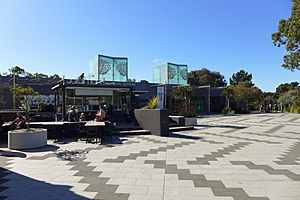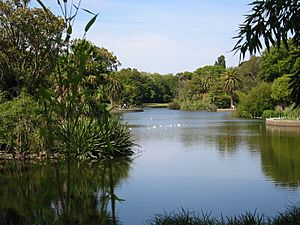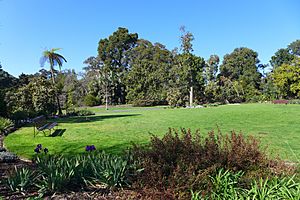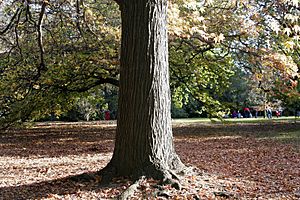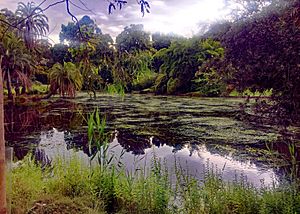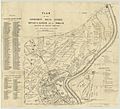Royal Botanic Gardens Victoria facts for kids
Quick facts for kids Royal Botanic Gardens Victoria |
|
|---|---|
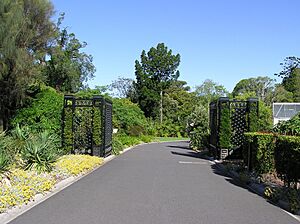
Royal Botanic Gardens, Melbourne entrance gate
|
|
| Type | Botanical garden |
| Location | Melbourne, Victoria, Australia |
| Area | 38 hectares (94 acres) |
| Operated by | Board of the Royal Botanic Gardens |
| Visitors | 2+ million (approx. per year) |
| Vegetation | Australian native, lawns, non-native traditional gardens |
| Connecting transport | Train, tram, bus, car |
| Facilities | Information centre, gift shop, toilets, barbecues, shelter, cafes |
| Website | rbg.vic.gov.au |
The Royal Botanic Gardens Victoria (RBGV) are amazing plant gardens found in two different places: Melbourne and Cranbourne. These gardens are special places where you can learn about plants from Australia and all over the world.
The Melbourne Gardens started in 1846. Land was set aside on the south side of the Yarra River for a new botanic garden. It covers about 38 hectares (that's like 70 football fields!). You'll find beautiful trees, garden beds, lakes, and grassy areas. There are almost 50,000 individual plants here, representing 8,500 different types of species. These are shown in 30 special plant collections.
Cranbourne Gardens began in 1970. Land was bought on Melbourne's south-eastern edge to create a garden just for Australian plants. It's a wilder place, important for protecting many different kinds of plants and animals. It opened to visitors in 1989. On its 363 hectares, you can explore native bushland, heathlands, wetlands, and woodlands. A highlight is the Australian Garden, which shows off Australian landscapes and plants. It has about 170,000 plants from 1,700 different varieties and was finished in 2012.
The Royal Botanic Gardens Victoria also keeps the State Botanical Collection. This huge collection is stored at the National Herbarium of Victoria. It has 1.5 million preserved plants, algae, and fungi. This makes it the biggest plant collection in Australia and the wider Oceania region. It also has Australia's best library about plants.
Contents
A Look Back: History of the Gardens
The gardens are managed by the Royal Botanic Gardens Board. This board follows the Royal Botanic Gardens Act 1991 and reports to the Minister for Environment.
Who Helped Shape the Gardens?
In 1846, Charles La Trobe chose the spot for the Royal Botanic Gardens. It was once a marshy, swampy area.
In 1857, Ferdinand von Mueller became the first director. He started the National Herbarium of Victoria and brought in many new plants.
In 1873, William Guilfoyle took over as Director. He changed the gardens to look more like the beautiful, natural-style gardens popular at the time. He added plants from tropical and cooler climates.
In 1877, Sir Edmund Barton, who later became Australia's first Prime Minister, got married to Jane Ross at the Royal Botanic Gardens.
In June 2015, all parts of the organization came together under one name: Royal Botanic Gardens Victoria. This included the Melbourne Gardens, Cranbourne Gardens, the National Herbarium of Victoria, and the Australian Research Centre for Urban Ecology.
Amazing Plant Collections to Explore
The Melbourne Gardens have many special groups of plants, called living collections. Here are some of them:
- Aotearoa New Zealand (plants from New Zealand)
- Australian Forest Walk (a walk through an Australian forest)
- Australian Rare and Threatened Species (plants that are hard to find or in danger)
- Cacti and Succulent (plants that store water, like cacti)
- Camellia (beautiful flowering shrubs)
- Climate Ready Rose Collection (roses that can handle different weather)
- Cycad (ancient palm-like plants)
- Eucalypt (gum trees, common in Australia)
- Fern Gully (a cool, shady spot with ferns)
- Guilfoyle's Volcano (a unique garden feature)
- Herb and Medicinal (plants used for cooking or medicine)
- The Ian Potter Foundation Children's Garden (a special garden for kids)
- North American Drylands (plants from dry parts of North America)
- Palm (tropical trees)
- Perennial Border (flowers that come back every year)
- Quercus (oak trees)
- Southern Africa (plants from southern Africa)
- Southern China (plants from southern China)
Nature's Balance: Plants and Animals
The gardens have a mix of plants that are native to Australia and plants from other countries. This means many different kinds of animals, both native and non-native, live here too. The gardens are home to over 10,000 types of flowers. Most of these are not native to Australia. In the past, seeds were traded between early European plant scientists. This led to many new plant types spreading across south-eastern Australia from these gardens.
Australia's Native Plants
When the gardens started in 1846, many native plants were removed. Plant scientists like Baron Von Mueller planted many species from around the world. At first, some native wetlands and swamps were left. But around the early 1900s, these areas were changed to create the Ornamental Lake. Still, some large native gum trees remain. One famous tree was the Separation Tree, a 300-year-old River Red Gum. It was under this tree that Victoria was declared a separate colony. Sadly, the Separation Tree was damaged in 2010 and 2013, and by 2015 it had died. The Royal Botanic Gardens, Cranbourne focuses only on Australian native plants.
Gardens from Around the World
The Royal Botanic Gardens Melbourne was first made to be a beautiful display for everyone to enjoy. Many seeds were shared between early European plant experts. They planted species from other countries. Important people like the Queen, Dame Nellie Melba, and Paderewski even helped plant trees at different times in the gardens' history.
Scientists Studying Plants
Since its very beginning, the Royal Botanic Gardens has been involved in studying and identifying plants. This work mainly happens at the National Herbarium of Victoria, located in the gardens. The Herbarium holds the State Botanical Collection. This collection has over 1.5 million dried plant samples. It also has a large collection of books, journals, and artworks about plants. The discoveries from this research are shared in a science journal called Muelleria. More recently, the Australian Research Centre for Urban Ecology was created. It specifically studies plants that grow in cities and towns.
Fun for Kids: The Children's Garden
The Ian Potter Foundation Children's Garden is a 5,000 square meter area. It's designed for children of all ages and abilities to explore and discover. This special garden is located in South Yarra, a bit away from the main gardens. It closes for two months each year after the Victorian July school holidays for rest and maintenance.
Around 2004 or 2005, a sculpture inspired by The Magic Pudding was placed in the garden. This sculpture was made by Louis Laumen. The idea for the children's garden came from Simon H. Warrender. He also asked for the sculpture to be made.
Get Active: The Tan Track
Just outside the Royal Botanic Gardens fence is a 3.8-kilometer jogging path. It's known as the Tan Track or simply the Tan. It was built in the 1900s as a track for horses. Later, it was changed for jogging and covered with fine, tan-colored gravel. The part along Anderson Street is paved. Clocks and distance markers were added in 2011. The Tan is the most famous and used jogging track in Melbourne.
Images for kids


